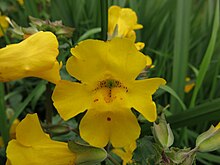| Erythranthe | |
|---|---|

| |
| E. peregrina in Scotland | |
| Scientific classification | |
| Kingdom: | Plantae |
| Clade: | Tracheophytes |
| Clade: | Angiosperms |
| Clade: | Eudicots |
| Clade: | Asterids |
| Order: | Lamiales |
| Family: | Phrymaceae |
| Genus: | Erythranthe (L.) G. L. Nesom |
| Type species | |
| Erythranthe cardinalis (Douglas ex Benth.) Spach ≡Mimulus cardinalis Douglas ex Bentham[1] 1835[2] | |
| Synonyms[1] | |
|
Mimulus sect. Erythranthe (Spach) Greene, Bull. Calif. Acad. Sci. 1: 108. 1885 | |
Erythranthe, the monkey-flowers and musk-flowers, is a diverse plant genus with more than 120 members (as of 2022) in the family Phrymaceae. Erythranthe was originally described as a separate genus, then generally regarded as a section within the genus Mimulus, and recently returned to generic rank. Mimulus sect. Diplacus was segregated from Mimulus as a separate genus at the same time. Mimulus remains as a small genus of eastern North America and the Southern Hemisphere. Molecular data show Erythranthe and Diplacus to be distinct evolutionary lines that are distinct from Mimulus as strictly defined, although this nomenclature is controversial.[3][4]
Member species are usually annuals or herbaceous perennials. Flowers are red, pink, or yellow, often in various combinations. A large number of the Erythranthe species grow in moist to wet soils with some growing even in shallow water. They are not very drought resistant, but many of the species now classified as Diplacus are. Species are found at elevations from oceanside to high mountains as well as a wide variety of climates, though most prefer wet areas such as riverbanks.
The largest concentration of species is in western North America, but species are found elsewhere in the United States and Canada, as well as from Mexico to Chile and eastern Asia. Pollination is mostly by either bees or hummingbirds. Member species are widely cultivated and are subject to several pests and diseases. Several species are listed as threatened by the International Union for Conservation of Nature.
- ^ a b Farr, E. R.; G. Zijlstra (eds.). "Index Nominum Genericorum (Plantarum) 1996". Smithsonian Institution. Retrieved 4 February 2017.
- ^ "The International Plant Names Index". The International Plant Names Index. Retrieved 4 February 2016.
- ^ Lowry, David B.; Sobel, James M.; Angert, Amy L.; Ashman, Tia-Lynn; Baker, Robert L.; Blackman, Benjamin K.; Brandvain, Yaniv; Byers, Kelsey J. R. P.; Cooley, Arielle M.; Coughlan, Jennifer M.; Dudash, Michele R. (2019). "The case for the continued use of the genus name Mimulus for all monkeyflowers". Taxon. 68 (4): 617–623. doi:10.1002/tax.12122. hdl:20.500.11820/cac4d1b0-516a-4027-bab9-b8fdcdca892b. ISSN 1996-8175. S2CID 208584689.
- ^ Nesom, Guy L.; Fraga, Naomi S.; Barker, William R.; Beardsley, Paul M.; Tank, David C.; Baldwin, Bruce G.; Olmstead, Richard G. (2019). "Response to "The case for the continued use of the genus name Mimulus for all monkeyflowers"". Taxon. 68 (4): 624–627. doi:10.1002/tax.12124. ISSN 1996-8175. S2CID 209602606.